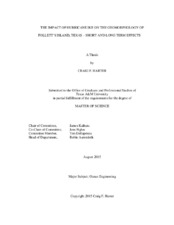| dc.description.abstract | In many places along the U.S. East and Gulf Coast, barrier islands are the first line of defense against extreme weather events threatening our coastlines. Follett’s Island is a sediment-starved barrier island located on the Upper Texas Coast; a stretch of coastline that experiences on average four hurricanes and four tropical cyclones per decade. As the topic of this thesis the impact of Hurricane Ike on Follett’s Island (FI), TX is studied. The goal of this study is to address how Hurricane Ike affected the sediment supply on the subaerial beach and foredune of FI, how the island recovered following the hurricane, and what physical processes governed the response of the island during the hurricane.
This study first outlines the collection of available hydrographic, atmospheric, aerial and survey data and provides an analysis of these data to characterize the long term metocean and geomorphological state of the island. It was found that water levels at FI during Hurricane Ike exceeded the 100 year water levels, and wave heights matched roughly the 40 year exceedance levels. From LiDAR surveys, it is clear that despite an initial sediment volume loss after the hurricane, the foredune and subaerial beach ultimately experienced a net gain in sediment volume (up to 25%), and an extension of the shoreline (up to 25 m) after a five year recovery period.
Numerical modeling tools XBeach and CSHORE were employed in an attempt to numerically reproduce the observed effects of the hurricane on FI. The ultimate goal of the numerical modeling is to show a real time response of the island during the passing of the storm, rather than the before and after snapshots provided by LiDAR data. XBeach displayed a decent model skill of 0.34 and was very useful in qualitatively visualizing erosion and deposition patterns. CSHORE also displayed a decent model skill of 0.33 and was able to accurately predict the post-storm beach slope and shoreline, but was less effective at simulating the foredune morphology.
Based on these data, the subaerial beach and foredune ultimately experienced a net gain in sediment volume after recovering from Hurricane Ike. This is a phenomenon that is contrary to the findings of other studies, and thus it is clear that sediment-starved barrier islands like FI need fundamentally different coastal protection considerations than other coastal systems. | en |


